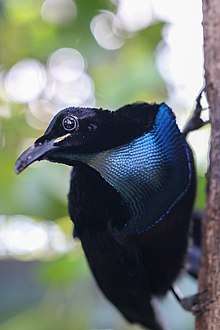Magnificent riflebird
The magnificent riflebird (Lophorina magnifica) is a species of passerine bird of the family Paradisaeidae.
| Magnificent riflebird | |
|---|---|
 | |
| Male Magnificent riflebird perched. | |
| Scientific classification | |
| Kingdom: | Animalia |
| Phylum: | Chordata |
| Class: | Aves |
| Order: | Passeriformes |
| Family: | Paradisaeidae |
| Genus: | Lophorina |
| Species: | L. magnifica |
| Binomial name | |
| Lophorina magnifica Vieillot, 1819 | |
| Synonyms | |
|
Ptiloris magnificus Craspedophora magnificus | |
Magnificent Riflebirds are widely distributed throughout lowland rainforests of western New Guinea and the northern Cape York Peninsula.
A widespread and relatively common species throughout its range, the magnificent riflebird is evaluated as a species of Least Concern on the IUCN Red List of Threatened Species. It is listed on Appendix II of CITES.
Taxonomy and systematics
The species formerly was named Ptiloris magnificus. Following further taxonomic analysis, the riflebirds were integrated within the Lophorina genus with the Superb and Vogelkop Superb Birds-of-Paradise, and the species was reclassified as Lophorina magnifica. This species used to be placed in its own genus, Craspedophora Gray, 1840, which is now a subgenus of Ptiloris/Lophorina.[2] The common name "riflebird" comes from the likeness of their black velvety plumage to the uniform of the British Army Rifle Brigade.[3]
_-_Paradisaeidae_-_bird_skin_specimen.jpeg)
Description
This riflebird is a medium-sized bird, being up to 34 cm long. The male is velvet-black bird-of-paradise with elongated black filamental flank plumes, an iridescent blue-green crown, a wide, triangle-shaped breast shield, and on central tail feathers. It has a black curved bill, yellow mouth, blackish feet and a dark brown iris. The female is brownish with dark spots and buff bars below with a white brow. The immature male resembles the male but with less tail plumes.[4]
Behavior and Biology
The diet of the magnificent riflebird consists mainly of fruits and a variety of invertebrates such as spiders, millipedes, etc.[4] Males are polygamous and perform solitary courtship displays on a 'dancing perch'. During these displays, the male fully extends his wings and raises his tail; he jerks upward while swinging his head from side to side, showing off his metallic blue-green breast shield, and producing a distinctive "woosh" sound as he flaps his wings. Multiple females will observe these displays, and, if satisfied with the performance, reward the male with mating rights. Females subsequently build nests, incubate, brood, and feed young without male assistance.[5]
_-_Paradisaeidae_-_bird_skin_specimen.jpeg)
Taxonomy and Subspecies
Now considered a separate species, the Growling Riflebird (Lophorina intercedens) is still occasionally considered conspecific with the Magnificent Riflebird, though genetic analysis proved it to merit specific status. The Magnificent Riflebird has two subspecies:
- Lophorina magnifica alberti Vieillot, 1819
- Lophorina magnifica magnifica, Elliot, 1871
References
- BirdLife International (2012). "Ptiloris magnificus". IUCN Red List of Threatened Species. 2012. Retrieved 26 November 2013.CS1 maint: ref=harv (link)
- Schodde, Richard (July 2010). "Handbook of the Birds of the World, vol. 14: Bush-shrikes to Old World Sparrows.— Josep del Hoyo , Andrew Elliott , and David Christie , Eds. 2009. Lynx Edicions, Barcelona, Spain. 893 pp., 51 color plates, 655 color photos, 484 distribution maps. ISBN 9788496553507. Cloth binding. $267.00". The Auk. 127 (3): 714–717. doi:10.1525/auk.2010.127.3.714. ISSN 0004-8038.
- Fraser, I.; Gray, J. (2013). Australian Bird Name - a complete guide. Collingwood, Victoria, Australia: CSIRO Publishing.
- Frith, C.; Frith, D. (2016). "Magnificent Riflebird (Ptiloris magnificus)". In del Hoyo, J.; Elliott, A.; Sargatal, J.; Christie, D.A.; de Juana, E. (eds.). Handbook of the Birds of the World Alive. Barcelona: Lynx Edicions.
- "Magnificent Riflebird (Lophorina magnifica)". www.hbw.com. Retrieved 2019-10-01.
| Wikimedia Commons has media related to Ptiloris magnificus. |
| Wikispecies has information related to Ptiloris magnificus |
